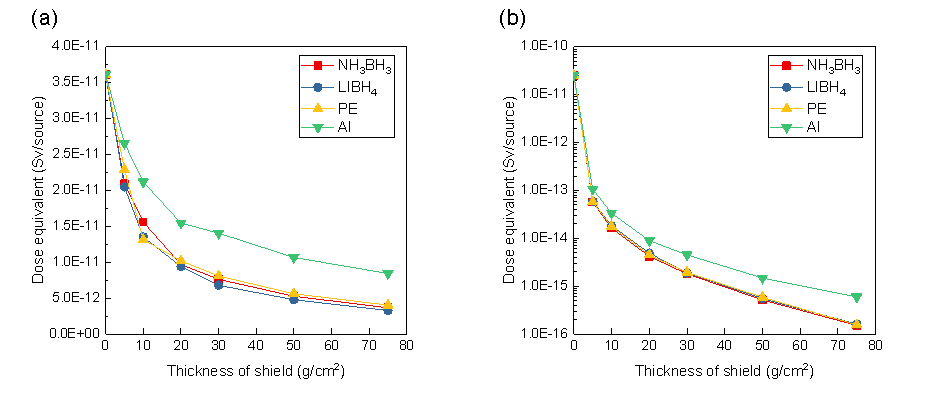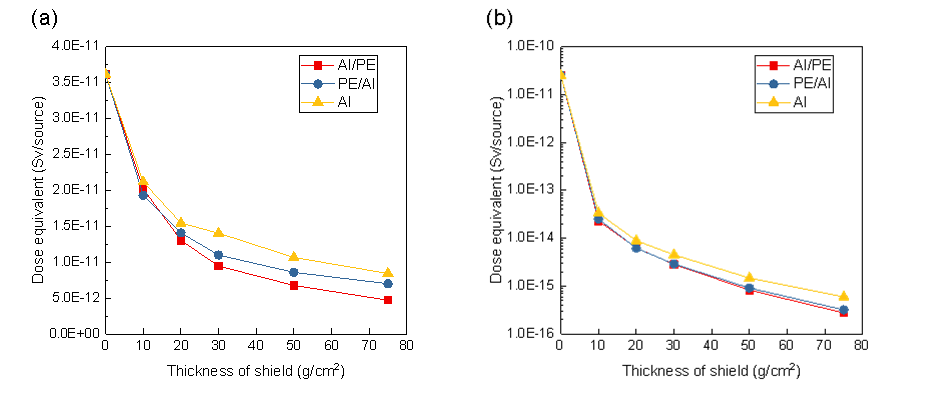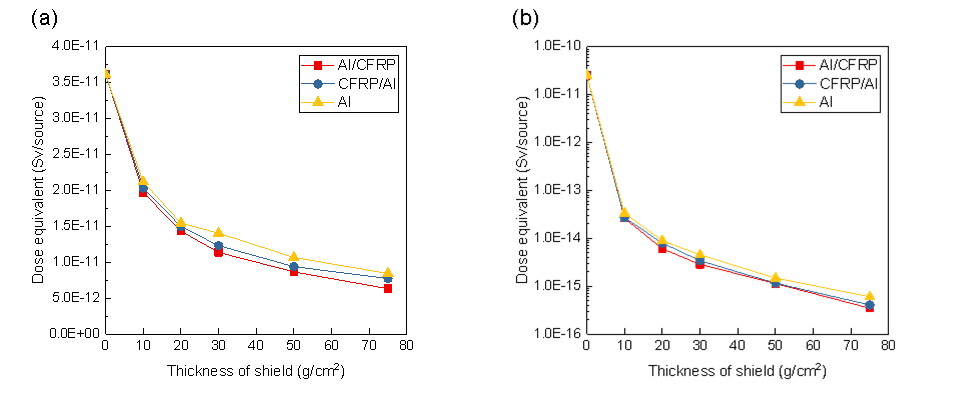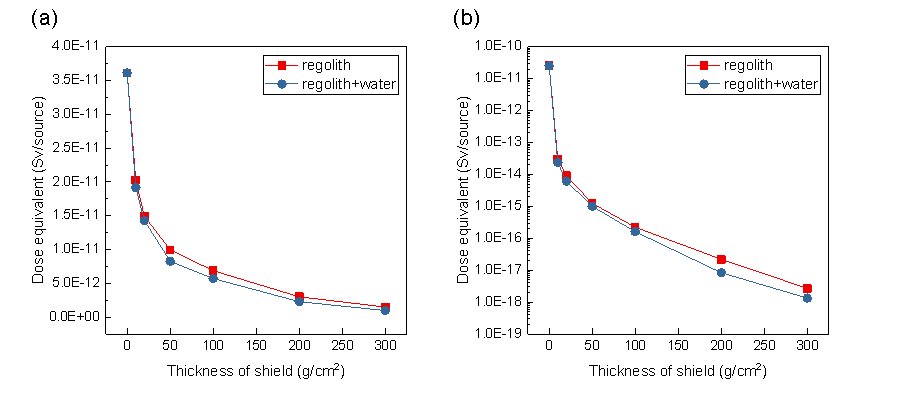Protection from Space Environment for Expanding Future Space Activities
JAXA Supercomputer System Annual Report April 2016-March 2017
Report Number: R16E0080
- Responsible Representative: Koji Yamanaka(Research and Development Directorate, Research Unit I)
- Contact Information: Aki Goto(goto.aki@jaxa.jp)
- Members: Aki Goto, Kazunori Shimazaki
- Subject Category: Space(Space utilization)
Abstract
Our goal is to obtain the technology and knowledge to protect spacecraft and astronauts from harsh space environment for expanding future space activities. Long-term-stay under safer environment is especially required in the future manned-mission. We, therefore, address the radiation shielding technology in terms of materials forsupporting the safe and long-period manned space activity.
Goal
Our goal is to obtain the technology and knowledge to protect spacecraft and astronauts from harsh space environment for expanding future space activities. Long-term-stay under safer environment are necessary in the future manned-mission. We, therefore, undertake research on the lightweight and effective shielding technology to reduce radiation dose in space. The findings from radiation shielding simulations are going to apply for the designing of next generation manned-spacecraft and resident modules.
Objective
We address a shielding technology for effectively decreasing radiation dose in spacecraft and on the moon/Mars. ①For the spacecraft, we aim for effective dose reduction by optimizing the structure of the spacecraft and the arrangement of the embarkation. ②For the activities on the moon’s / Martian surface, we consider the method of manufacturing a simple shielding structure using local regolith, other materials and so on.
References and Links
N/A
Use of the Supercomputer
We use JSS2 for PHITS (Particle and Heavy Ion Transport code System) Monte Carlo simulations to estimate shielding effects of materials against space radiations.
Necessity of the Supercomputer
PHITS Monte Carlo simulations take a large amount of time when the computational system is large and complex, such as the system simulated manned-spaceship structure. Such simulations enable to be run at high speed with statistical accuracy by using JSS2.
Achievements of the Year
JAXA is planning future manned space missions following the International Space Station (ISS) mission, such as a long-term stay onboard lunar orbital station and exploration of the Moon / Mars. Outside the geomagnetic field, where the future manned missions will be performed, astronauts are exposed to high linear energy transfer (LET) radiations namely galactic cosmic rays (GCRs) and solar energetic particles (SEPs). As high-LET radiations cause significant biological damage, the development of radiation protection technologies is desired to safely carry out the future manned missions.
We started a study of space radiation shielding materials. In FY28, we are focusing on three key materials: hydrogen rich material, multi-layer material, and lunar regolith containing material, and investigating their shielding effects by PHITS (Particle and Heavy Ion Transport Cord System1) simulations. In this report, we introduce the simulation results.
1) hydrogen-rich materials
Low atomic number (Z) elements are effective for space radiation shielding. Hydrogen (1H) is known as a most effective element. Polyethylene (PE) contains a lot of hydrogen (H: 14 wt%), and high shielding effects of PE are confirmed by simulations and irradiation tests. No radiation shielding material that is lower weight and more efficient than PE has been reported so far. Then, materials having higher hydrogen density than that of PE seem to be useful radiation shielding materials.
We focused on hydrogen storage materials having higher hydrogen density than PE (ammonia borane (NH3BH3) and lithium borohydride (LiBH4)). The shielding effects of the materials were investigated by PHITS simulation. CREME962 was adopted as the GCR (Solar-Quiet (no ‘flare’) Model; Solar Minimum) and GCR+SEP (Solar Energetic Particle (‘flare’) Model; Worst-Day) spectra. The dose equivalent in a water target placed behind the shield was simulated.
Radiation shielding effects of the hydrogen storage materials (NH3BH3 and LiBH4), Al, and PE against the space radiations simulated are shown in Fig. 1. The shielding effects of the hydrogen storage materials were almost the same as those of PE. Therefore, the hydrogen storage materials are not useful compared with PE in terms of the lightweight, safety, and cost.
2) multi-layer materials
As mentioned above, low atomic number (Z) elements are effective for space radiation shielding. For this reason, the partial replacement of Al structure material for spaceship with lower Z material, such as resin or CFRP (carbon fiber reinforced plastic), seems to be effective technique for radiation shielding.
Then, the shielding effects of Al/PE (resin) 2-layer materials and Al/CFRP 2-layer materials were investigated by PHITS simulations. CREME962 was adopted as the GCR (Solar-Quiet (no ‘flare’) Model; Solar Minimum) and GCR+SEP (Solar Energetic Particle (‘flare’) Model; Worst-Day) spectra. The dose equivalent in a water target placed behind the shield was simulated. The thickness ratios of Al to PE and Al to CFRP were 1:1 in surface density, respectively. In order to investigate the influence of the sequences of materials, simulations of 2-layer materials were run in two cases, such as placing Al upstream (Al/PE and Al/CFRP) and downstream (PE/Al and CFRP/Al) of radiations.
Radiation shielding effects of Al/PE 2-layer materials and Al against the space radiations simulated are shown in Fig. 2. The shielding effects of Al/PE 2-layer materials were higher than those of Al. Additionally, Al/PE 2-layer material could shield effectively compared with PE/Al 2-layer material. The simulation results of Al/CFRP 2-layer materials were almost the same as that of Al/PE 2-layer materials (Fig. 3). Therefore, it suggested that the partial replacement of Al with lower Z material is an effective technique for space radiation shielding, and optimization of the shielding design enables by changing sequences of some materials.
3) regolith containing materials
One of the methods to reduce the weight of shielding materials used in the missions on the Moon / Mars is using local regolith. In order to examine the design of new regolith-containing radiation shielding materials, we investigated the necessity of addition of water (or hydrogen) to regolith.
The shielding effects of regolith and regolith-water mixture (regolith/water = 1 (wt%)) were simulated by PHITS simulations. CREME962 was adopted as the GCR (Solar-Quiet (no ‘flare’) Model; Solar Minimum) and GCR+SEP (Solar Energetic Particle (‘flare’) Model; Worst-Day) spectra. The dose equivalent in a water target placed behind the shield was simulated. The composition of regolith was SiO2 (49.3 wt%), TiO2 (1.9%), Al2O3 (16.3 wt%), FeO (8.3 wt%), Fe2O3(4.8 wt%), MnO (0.2 wt%), MgO (3.8 wt%), CaO (9.1 wt%), Na2O (2.8 wt%), K2O (1.0 wt%), and P2O5(2.4 wt%).
Radiation shielding effects of regolith and regolith-water mixture against the space radiations are shown in Fig. 4. The shielding effects of regolith-water mixture were higher than those of regolith. However, increasing shielding thickness was more effective for shielding than addition of water. Accordingly, it seems that quick and easy manufacturing for thick shielding is more important than addition of water (or hydrogen) for new regolith-containing shielding materials.

Fig.1:Dependence of dose equivalent in a water target on shielding thickness of hydrogen storage materials (NH3BH3, LiBH4), PE, and Al) against GCR (a), and GCR+SEP (b).)

Fig.2:Dependence of dose equivalent in a water target on shielding thickness of Al/PE 2-layer material (Al/PE and PE/Al) and Al against GCR (a) and GCR+SEP (b).)

Fig.3:Dependence of dose equivalent in a water target on shielding thickness of Al/CFRP 2-layer material (Al/CFRP and CFRP/Al) and Al against GCR (a) and GCR+SEP (b).)

Fig.4:Dependence of dose equivalent in a water target on shielding thickness of regolith and regolith+water mixture against GCR (a) and GCR+SEP (b).)
Publications
Presentations
1) ○A. Goto, K. Shimazaki, Y. Kimoto, H. Matsumoto, and A. Nagamatsu, PHITS Simulations for Development of Space Radiation Shielding Materials, 31 st ISTS, Matsuyama, Japan, Jun 6, 2017.
Computational Information
- Parallelization Methods: Process Parallelization
- Process Parallelization Methods: MPI
- Thread Parallelization Methods: n/a
- Number of Processes: 72
- Number of Threads per Process: 1
- Number of Nodes Used: 1-6
- Elapsed Time per Case (Hours): 8.33
- Number of Cases: 50
Resources Used
Total Amount of Virtual Cost(Yen): 1,091,066
Breakdown List by Resources
| System Name | Amount of Core Time(core x hours) | Virtual Cost(Yen) |
|---|---|---|
| SORA-MA | 0.00 | 0 |
| SORA-PP | 123,777.16 | 1,056,809 |
| SORA-LM | 0.00 | 0 |
| SORA-TPP | 0.00 | 0 |
| File System Name | Storage assigned(GiB) | Virtual Cost(Yen) |
|---|---|---|
| /home | 14.31 | 61 |
| /data | 4,978.18 | 21,523 |
| /ltmp | 2,929.69 | 12,666 |
| Archiving System Name | Storage used(TiB) | Virtual Cost(Yen) |
|---|---|---|
| J-SPACE | 0.00 | 6 |
Note: Virtual Cost=amount of cost, using the unit price list of JAXA Facility Utilization program(2016)
JAXA Supercomputer System Annual Report April 2016-March 2017


